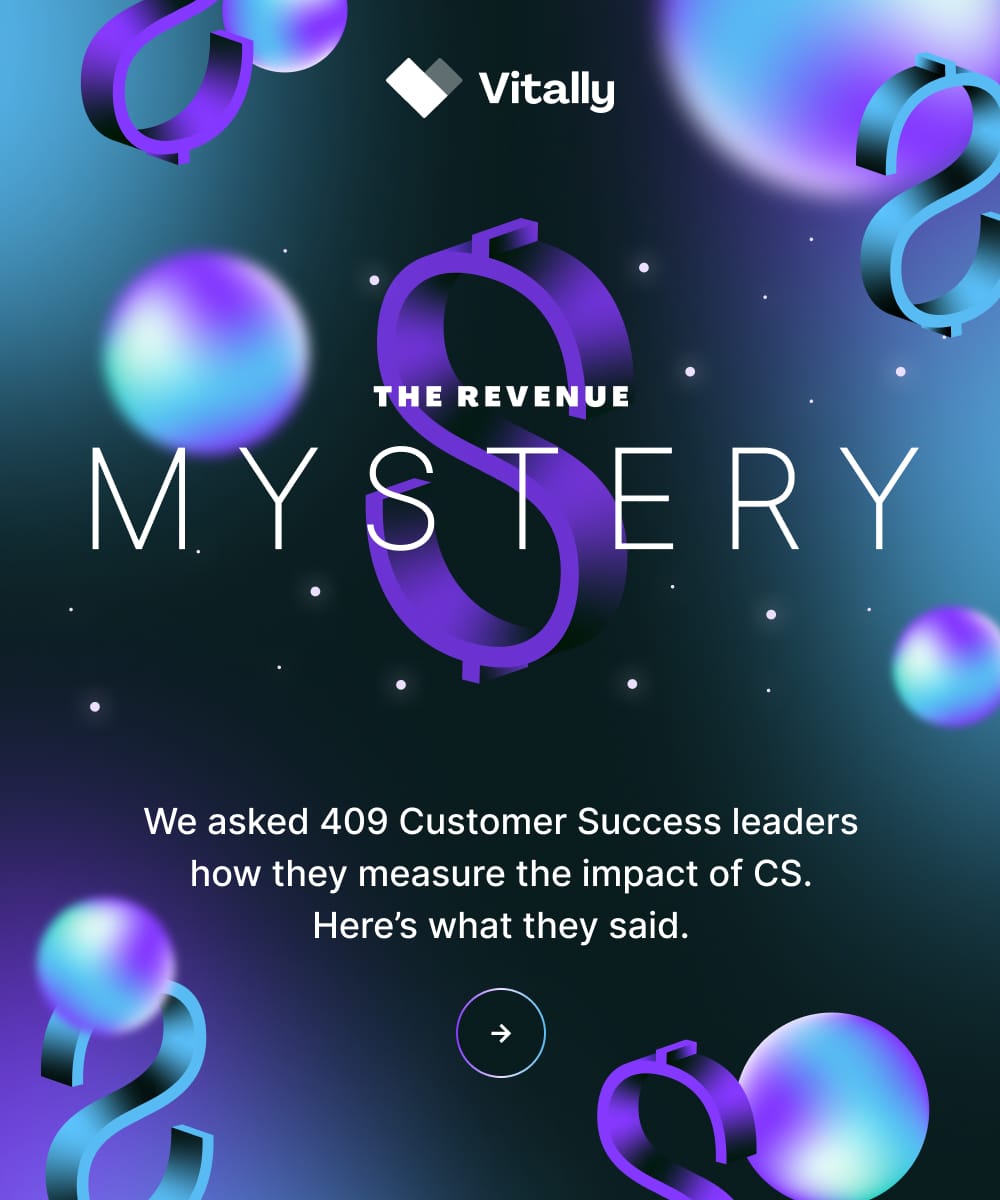
"CRO isn’t just another name for a VP of Sales, but unfortunately, it’s being used that way — and it pisses me off."
These words aren’t ours (though we wholeheartedly agree with them). They belong to Ed Porter, the Owner and Chief Revenue Officer at Blue Chip CRO and a valuable thought leader within Vitally’s Success Network.
After a dynamic career in revenue leadership, Ed took what he learned and started providing fractional CRO services for growing or restructuring companies with $0–$20M in ARR — and he was kind enough to share some of his expertise with us for this article.

Here you’ll find Ed’s take on what top CROs are thinking about today, where Customer Success fits in, and how CS software makes it easier to hit goals as a Chief Revenue Officer.
A CRO’s Job Description Boils Down to Three Things
It doesn’t make sense to focus on the bells and whistles of a top-rated Customer Success Platform (CSP) without first stepping back and understanding what CROs actually pay attention to at work. After all, software is only as helpful as the problems it solves and the needs it meets. These are a CRO’s top needs.
1. Stability Within Their Organization
A CRO should wake up every day thinking about how to make revenue gains and losses more predictable to reduce the volatility of their company.
Of course, the stability of any company isn’t ever in the control of just one person or even just the go-to-market (GTM) organization, but it is up to the CRO to put systems in place that make revenue as predictable as possible, especially when it comes to retention and expansion. Because, as Ed says, “if the water is leaking out of the bucket, you’re in trouble.”
2. Understanding of the Full Buyer Lifecycle
Optimizing the pre-sale buyer experience is part of a CRO’s job, but the “sustainability of revenue growth and preservation of revenue” are two post-sales motions many CROs neglect today, Ed says.
Future-focused CROs understand that signing on the dotted line is just the start of the revenue relationship, not the end. That’s why it’s so important for CROs to have visibility into the full post-sale buyer lifecycle without having to piece-meal things together based on ad-hoc conversations with sellers and deal notes. The savviest CROs are finding ways to consolidate tons of buyer and customer data into clean, big-picture reports that give them legitimate insights to act upon.
3. Dedication to the Leaders of Their Revenue Organization
Any CRO worth their salt is paying close attention to their leadership team — the folks in their charge who lead Customer Success, Sales, Marketing, and RevOps. So much of being a great CRO is being good at coaching these key leaders to find (and solve) the right problems:
“CROs shouldn’t be talking tactics. They should be helping the leaders beneath them in the revenue organization run their teams properly and measure their performance. CROs should be able to answer: What's every team doing? What's the output of what every team is doing? Are they on pace based on the goals we set for the year?”
If you’re worried every day about things like pipeline, then you're diminishing the responsibility of the leaders you serve.
So, What Do CROs Need in Customer Success Software?
The three priorities above — the ability to predict revenue, understand the buyer experience, and coach GTM leaders — all become significantly easier with a CSP.
Here’s what Ed says he’d look for if he were an in-house CRO shopping for a Customer Success Platform to make it easier to hit his goals.
👀 Visibility Into the Full Buyer Lifecycle
You’ll want a CSP that lets you see everything — from someone’s first interaction with your brand to today’s meeting notes — about your customers.
For a CRO to see and optimize for a seamless buyer experience across Marketing, Sales, and CS, there have to be systems in place to make what’s happening with leads, buyers, and customers visible.
And spoiler, CRMs by themselves are not enough to track all of these shenanigans at scale; at least not on the post-sales side. To keep buyer journey data accessible, a CRO needs to equip their VP of CS and CS teams with a tool that clearly shows:
- Which blueprints and templates lead to higher retention rates
- Which actions and behaviors indicate a customer is ready to expand
- How accurately Customer Health Scores predict churn
CROs should also have easy, always-on access to these kinds of insights themselves to make better recommendations and decisions as leaders.
🤝 Excellent Onboarding Tracking and Touchpoint Analytics
Revenue from current customers is low-hanging fruit compared to revenue from net-new logos, which is why top CROs don’t let their onboarding look like running a few demos, issuing logins, and then assigning new customers a random CSM.
Ed goes so far as to say that “onboarding is the number one preventer of churn.” If you get onboarding right and understand why a customer bought from you, establishing goals and collaborating on them gets easier — and it gets infinitely easier with a CSP built for collaboration. (Especially with a CSP that offers easy onboarding for CSMs, too.)
While tracking touchpoints and milestones during onboarding is important, it shouldn’t stop there. Great CROs partner with their VP of Customer Success to adequately track and aggregate every customer interaction. Find a Customer Success software platform that integrates easily with your existing stack and pulls in information from your ticketing system, surveys, email, instant messaging system (like Slack or Teams), and actual product.
This data all under one roof makes for comprehensive, accurate reporting, better Health Scores, and a clearer understanding of when a customer is thriving or at risk of churn. Find CS software that makes intervention at the right time easier (and maybe even automates it).
🔗 A Way to Connect With Customers Via Indirect Channels
The last thing Ed would look for in Customer Success software is a way to build customer connections that have nothing to do with Zoom, Teams, or Google Meet.
“The worst thing that good Customer Success teams do is talk to their customers too often,” Ed says.
Engaging with customers without talking to them looks like working with your VP of Marketing to make sure the content marketing team isn’t just creating lead magnets, but rather content that’s helpful to existing customers, and sending it out via automated playbooks.
It looks like investing in customer communities and engaging with customers on their terms at conferences and tradeshows. It looks like noting big life and work milestones with a gift. Your customer interactions should feel personal, not prescriptive. This tailored, scaled CS-esque approach is only possible with CS software.
One side note here: Great CS software does away with the need for QBRs as we’ve known them. Ed aptly points out that your customers likely have half a dozen other vendors, all of which want to have a QBR and get “face time.” There’s value in QBRs for sure, but where there’s more value is in this advice Ed heard from Jeff Breunsbach, the Co-Founder of Gain Grow Retain and current Co-Founder and Editor of GrowthCurve.io: Try to inject yourself into your customer’s staff meetings. Ask to be a part of their conversations instead of the other way around.
This only works, though, if the customer has access at all times to the data you’d present in a QBR. Give them the keys to the kingdom with a software that lets them see progress on their goals, past notes from conversations with their CSM, and collaborative Docs. This digitizes QBRs in a way that’s easier on both them and your team.
Vitally Is a CRO’s Ticket to CS Productivity, Visibility, and Collaboration
To be a CRO who leads their broader GTM organization to preserve and expand revenue, you need intuitive, ROI-proven Customer Success software.
We’d argue that software should be Vitally. Our tool is designed for in-the-weeds work between customers and CSMs and for C-suite execs who want an all-in-one workspace to see what’s happening across the CS org. CROs who use Vitally are equipped to make better decisions that will scale their businesses.
Want a look behind the curtain at Vitally? Take an interactive tour of our platform, or book time with a Vitally rep today.










